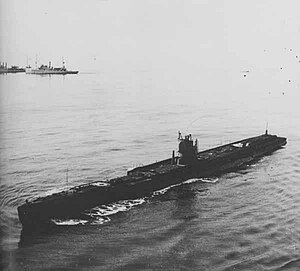 SM U-117 at Cape Charles
| |
| Class overview | |
|---|---|
| Builders |
|
| Operators | |
| Subclasses | U-122 |
| Built | 1917–1918 |
| In commission | 1917–1918 |
| Completed | 10 |
| Lost | 4 |
| Scrapped | 6 |
| General characteristics | |
| Type | Ocean-going mine-laying submarine |
| Displacement | 1,164 t (1,146 long tons) surfaced; 1,512 t (1,488 long tons) submerged |
| Length | 81.52 or 82 m (267 ft 5 in or 269 ft 0 in) |
| Beam | 7.42 m (24 ft 4 in) |
| Draft | 4.22 m (13 ft 10 in) |
| Installed power | |
| Propulsion | 2 shafts; 2 diesel engines, 2 electric motors |
| Speed |
|
| Range |
|
| Test depth | 75 m (246 ft) |
| Complement | 4 officers, 36 enlisted men |
| Sensors and processing systems | 2 periscopes |
| Armament |
|
The Type UE II submarines were a class of submarines built by the German Empire during World War I as long-range mine-layers.
UE II boats carried 14 torpedoes and were armed with one 150 mm deck gun. They carried a crew of 40 and had a cruising range of about 9,400 miles. Nine were built between 1917 and 1918.[1]
The UE IIs joined the conflict in the middle of 1917, at a time when the tide of the war was turning against Germany. In the months beforehand, the United States Navy was added to the ranks of their enemies; and the convoy system was introduced, making it difficult to engage enemy merchant shipping without being spotted by destroyer escorts.[2] Because they entered service late in the war, the UE IIs only sank 23 ships and damaged 4 others before the end of hostilities. SM U-117 was by far the most successful U-boat, taking credit for 20 ships sunk out of the total of 23 for the entire type.[3] The UE II's were the last of the UE class U-boats built by the German Imperial Navy; the last of the class, U-126, was commissioned on 3 October 1918, a little over a month before the armistice at Compiègne.[4]
- ^ Helgason, Guðmundur. "WWI U-boat Types: Type UE 2". German and Austrian U-boats of World War I - Kaiserliche Marine - Uboat.net. Retrieved 24 January 2010.
- ^ Goebel, Greg (24 December 2008). "The First Battle of the Atlantic". Vectorsite.net. Retrieved 25 January 2010.
- ^ Helgason, Guðmundur. "WWI U-boats: U 117". German and Austrian U-boats of World War I - Kaiserliche Marine - Uboat.net. Retrieved 24 January 2010.
- ^ Helgason, Guðmundur. "WWI U-boats: U 126". German and Austrian U-boats of World War I - Kaiserliche Marine - Uboat.net. Retrieved 24 January 2010.